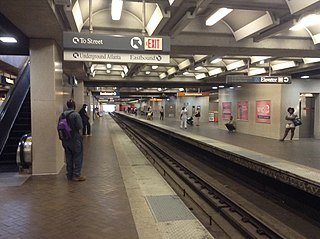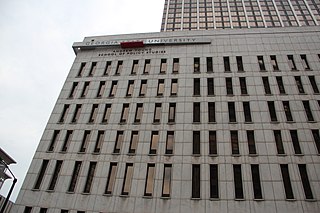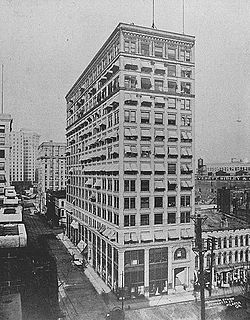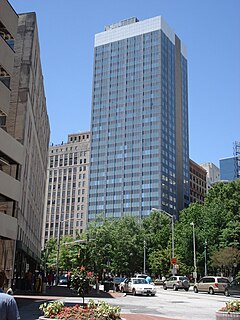
Bank of America Plaza is a skyscraper located in between Midtown Atlanta and Downtown Atlanta. At 311.8 m (1,023 ft), the tower is the 107th-tallest building in the world. It is the 16th tallest building in the U.S., the tallest building in Georgia and the tallest building in any U.S. state capital, overtaking the 250 m (820 ft), 50-story One Atlantic Center in height, which previously held the record as Georgia's tallest building. It has 55 stories of office space and was completed in 1992, when it was called NationsBank Plaza. Originally intended to be the headquarters for Citizens & Southern National Bank, it became NationsBank's property following its formation in the 1991 hostile takeover of C&S/Sovran by NCNB.

The architecture of Atlanta is marked by a confluence of classical, modernist, post-modernist, and contemporary architectural styles. Due to the complete destruction of Atlanta by fire in 1864, the city's architecture retains no traces of its Antebellum past. Instead, Atlanta's status as a largely post-modern American city is reflected in its architecture, as the city has often been the earliest, if not the first, to showcase new architectural concepts. However, Atlanta's embrace of modernism has translated into an ambivalence toward architectural preservation, resulting in the destruction of architectural masterpieces, including the Commercial-style Equitable Building, the Beaux-Arts style Terminal Station, and the Classical Carnegie Library. The city's cultural icon, the Neo-Moorish Fox Theatre, would have met the same fate had it not been for a grassroots effort to save it in the mid-1970s.

The Fairlie–Poplar Historic District is part of the central business district in downtown Atlanta. It is named for the two streets that cross at its center, northeast-only Fairlie and southeast-only Poplar. Fairlie–Poplar is immediately north of Five Points, the definitive centerpoint and longtime commercial heart of Atlanta. It is roughly bounded on the southwest by Marietta Street, on the southeast by Peachtree Street or Park Place, on the northeast by Luckie Street or Williams Street, and on the northwest by Cone Street or Spring Street. It has smaller city blocks than the rest of the city, and the streets run at a 40° diagonal.

Atlanta City Hall is the headquarters of the City of Atlanta government. It was constructed in 1930, and is located in Downtown Atlanta. It is a high-rise office tower very similar to dozens of other city halls built in the United States during the same time period. Located in South Downtown, it is near other governmental structures, such as the Georgia State Capitol and the Fulton County Courthouse. The Neo-Gothic structure features many architectural details that have helped to make the building a historical landmark. It is Atlanta’s fourth city hall.

Downtown Atlanta is the central business district of Atlanta, Georgia, United States. The largest of the city's three commercial districts, it is the location of many corporate or regional headquarters; city, county, state and federal government facilities; Georgia State University; sporting venues; and most of Atlanta's tourist attractions. It measures approximately four square miles, and had 26,700 residents as of 2010. Similar to other central business districts in the United States, it has recently undergone a transformation that included the construction of new condos and lofts, renovation of historic buildings, and arrival of new residents and businesses.

Five Points is a metro station of the Metropolitan Atlanta Rapid Transit Authority (MARTA) rail system in Atlanta, Georgia. It is the transfer point for all rail lines and serves as the main transportation hub for MARTA. It provides access to Station Soccer, the Five Points Business District, Underground Atlanta, City Hall, the Richard B. Russell Federal Building, Cobb Community Transit, Gwinnett County Transit, GRTA Xpress Transit, and the tourism heart of Downtown Atlanta. It provides connecting bus service to Zoo Atlanta, Grant Park, Atlanta University Center, East Atlanta Village, Martin Luther King, Jr., National Historic Site, Carter Center, Atlanta City Hall, South Dekalb Mall and Fulton County Government Center.

The Candler Building is a 17-story highrise at 127 Peachtree Street, NE, in Atlanta, Georgia. When completed in 1906 by Coca-Cola magnate Asa Griggs Candler, it was the tallest building in the city. This location where Houston joins Peachtree Street was the location of one of the earliest churches in the city which was built on land donated by Judge Reuben Cone in the 1840s. It forms the northern border of Woodruff Park.

101 Marietta Street, formerly Centennial Tower, is a 140 m (460 ft), 36-story skyscraper in downtown Atlanta, Georgia. The building was completed in 1975 and renovated in 1998, resulting in a name change, new facade, and chevrons added to the building which increased its original 136 m (446 ft) height by 4 m (13 ft). The property is considered a class "A" office building consisting of 600,000 square feet.

The Andrew Young School of Policy Studies is located within Georgia State University. The school houses the Criminal Justice & Criminology, Economics, Social Work and Public Management and Policy divisions of the second largest school in the state of Georgia.

The Hurt Building is an 18-story building located at 50 Hurt Plaza in Atlanta, Georgia with a unique triangular shape. One of the nation's earliest skyscrapers, the Hurt Building was built between 1913 and 1926, and was the initial home for the Federal Reserve Bank of Atlanta. It was renovated in 1985. It was added to the National Register of Historic Places in 1977.

The Corbin Building is a historic office building located at 13 John Street at the corner of Broadway – where it is numbered as 192 – in the Financial District of Manhattan, New York City. It was built in 1888-89 and was designed by Francis H. Kimball in the Romanesque Revival style with French Gothic detailing. The building was named for Austin Corbin, a president of the Long Island Rail Road who also founded several banks. It was built as a speculative venture for use as office space or housing.

The J. Mack Robinson College of Business Administration Building is a 14-story highrise at the corner of Broad and Marietta streets in the Fairlie-Poplar district of downtown Atlanta, which houses the business school of Georgia State University. When completed in 1901 as the Empire Building, it was the first steel-frame structure and the tallest in the city, until surpassed by the Candler Building in 1906.

Five Points Plaza, also known as 40 Marietta Street and formerly known as First Federal Building, is a 17 storey, 73 m (240 ft) office building skyscraper in Atlanta, Georgia. The building was constructed in 1964 to house headquarters of the First Federal Savings and Loan Association of Atlanta. Noted for an Oriental architectural design that stands out in Atlanta, the building is devoid of interior columns, making it one of the tallest post-tensioned concrete buildings in the United States at the time of its construction. Five Points Plaza is fully leased to the Atlanta offices of the Department of Housing and Urban Development through 2019.

Morgan & Dillon was a major architectural firm of Atlanta, Georgia. It later became Morgan, Dillon & Lewis.

The Metropolitan is a condominium building at 20 Marietta Street NW at the southeast corner of Broad Street in the Five Points district of Downtown Atlanta. It was built in 1911 as the Third National Bank Building. It was later the Atlanta Federal Savings and Loan Building, and in the 1960s was resurfaced with dark glass. It was converted into condominiums in 1996.

Marietta Street is a historic street in Downtown Atlanta. The street leads from Atlanta towards the town of Marietta, as its name indicates. It begins as one of the five streets intersecting at Five Points, leading northwest, forming the southern border of Downtown's Fairlie-Poplar district, continuing through Downtown's Luckie Marietta district, then entering West Midtown's Marietta Street Artery neighborhood, until terminating at its junction with West Marietta St., Brady Ave., and 8th St.

The U.S Post Office and Customs House in Atlanta was a landmark building located on Marietta Street, occupying the block bounded by Marietta, Fairlie, Walton and Forsyth streets in the Fairlie-Poplar district of Downtown Atlanta. The building opened in 1878. In 1910 the City acquired the building and it was used as the Atlanta City Hall until 1930, after which it was razed. The lot was rebuilt in 1958 as the Fulton National Bank building, now the 55 Marietta Street building.




















